Table of Contents[Hide][Show]
How to make homemade ghee on the stovetop quickly and easily for a healthy cooking fat that is shelf stable and nourishing.
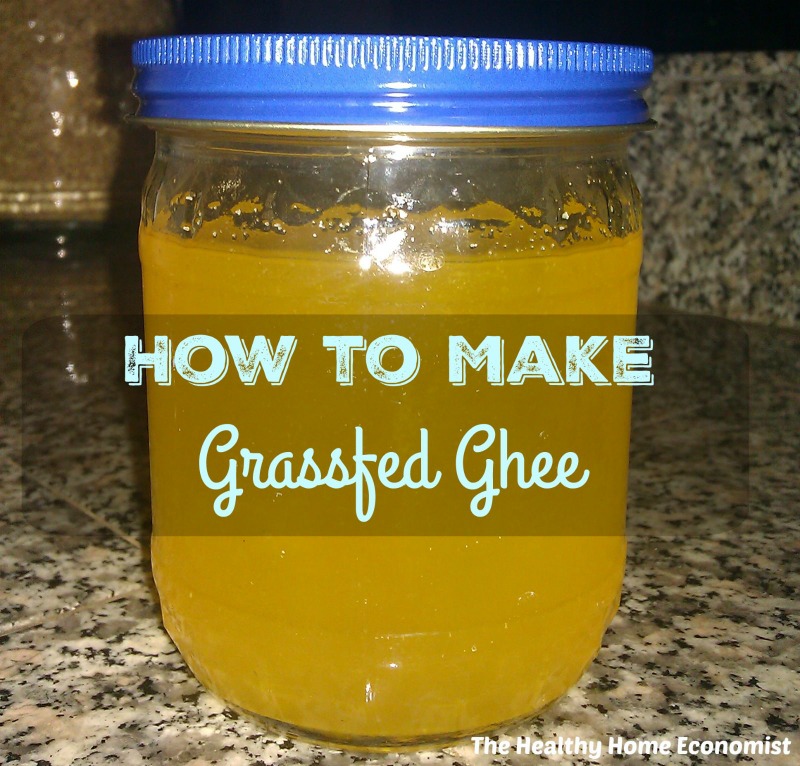
Knowing how to make ghee is simply a must for any Traditional Cook. Clarified butter as it is also known, has been used for thousands of years by Indian cultures. In fact, traces of ghee have been found on fragments of Indian pottery dating as far back as 6500 BC!
When in a liquid state and made from unheated butter, ghee is called butter oil. Dr. Weston A. Price discovered that butter oil and cod liver oil work synergistically to supercharge absorption of Vitamins A, D, and K2 known as the X-factor.
Dr. Price always carried flasks of cod liver oil and butter oil to the bedside of very ill patients. More often than not, he was able to revive them with a few drops of each under the tongue. Using cod liver oil or butter oil separately did not have the same deathbed reviving effects.
Benefits of Ghee over Other Cooking Fats
It is best to know how to make clarified butter oil or ghee yourself rather than buying from the store. Notice the picture above of a jar that I made myself with pastured butter from a local farm. It is so yellow!
Commercial ghee from the store is a pale yellow, indicating lower nutritional value from cows eating grain mix instead of fresh green grass.
Ghee from the store is also ridiculously expensive, so learning to make it yourself is not only a more nutritious way to go, it is very cost-effective.
I make clarified butter oil for about half the cost of what it would be to buy it at the health food store.
Unlike butter, ghee does not need refrigeration and keeps well on the counter or pantry for many months. Keeping a jar in the pantry for a quick veggie saute is very convenient!
Another benefit of ghee is that it is easier to digest as all the milk solids (proteins) have been removed from the butter. Very frequently, even those with a true dairy allergy find that ghee presents no trouble for them.
Another advantage to using clarified butter instead of plain grass-fed butter is that the grassy taste and sometimes cheesy smell of the butter is eliminated.
Therefore, by learning to make clarified butter oil from grass-fed butter, you will find that you now have a healthy fat for cooking that does not displease your family with a cheesy odor. This can sometimes happen with grass-fed butter alone.
Homemade Grass-Fed Ghee
The recipe and video lesson below covers how to make this healthy and indispensable fat for use in your own kitchen.
I also cover how to make clarified butter capsules. This is a convenient way to take butter oil with your daily dose of cod liver oil.
If you are spending money on high vitamin cod liver oil (this is the brand I’ve used since 2015) it is a must to be taking it with clarified butter oil. This supercharges the beneficial effects!
Note that it is not advisable to make ghee from homemade raw butter. The heating process causes a loss of the enzyme and probiotics in this special food.
Prefer to Buy?
If after reviewing the recipe and video demo below you decide to buy instead, I would recommend this vetted source as a premier retailer of quality grass-fed ghee. Plain, cultured, and herb-flavored varieties are all available including a coconut oil/ghee blend.
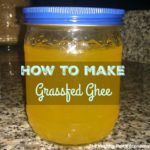
How to Make Ghee
This simple recipe for making ghee can be accomplished on the stovetop in just a few minutes.
Ingredients
- 1 lb butter preferably grassfed and organic
- 1 wide mouthed mason jar quart size
- 1 cheesecloth fine mesh
- 1 funnel
Instructions
-
Place pound of butter in a medium sized pot or stove safe glass bowl. Turn heat on low and allow the butter to gently liquefy.
-
Turn heat to medium-low and gently remove foam that comes to the top of the melted butter with a slotted spoon.
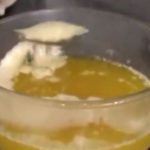
-
After removing the foam, allow the melted butter to simmer on medium-low heat for 5-10 minutes longer to allow all the milk solids to settle out on the bottom of the bowl. You will know when the separation process is complete as the solids will be slightly brown on the bottom and the clarified butter will be completely clear and transparent.
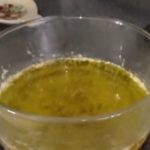
-
Line a funnel placed into the open end of a wide mouthed mason jar with a fine mesh cheesecloth.
-
Pour the clarified butter into the funnel so that it is strained through the cheesecloth as it enters the mason jar.
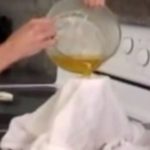
-
Allow the finished ghee to cool in the mason jar. When room temperature, fasten the lid on tightly and store in the pantry as a convenient and incredibly healthy cooking oil for all your kitchen needs.








Do you have to cook it reaylly (I mean: take to 100 degrees), I thaugth you only had to warm it?
Ashley Rozenberg, nutrapro hvbo has been successfully tested in my house. It has stopped cavities in their tracks. I switched due to cost to Pure Indian foods ghee, which advertises it is hvbo, but within a month a new cavity appeared. Switched back, stopped in its tracks. I’m dealing with cavities in baby teeth, so I don’t expect regeneration, just to stop the decay, which the Fclo and nutrapro hvbo does. Maybe ghee works for others who don’t have very cavity prone teeth, but it failed me twice.
All I can get here is pastured ‘pasteurized’ butter to make my ghee, & it isn’t from the fall months :/ I guess it’s better than nothing, right?
Jeanette, there is probably still water in the ghee. Try cooking it a bit longer until the surface of the ghee becomes quiet. It will burn quickly at that point so take it off the heat immediately and transfer it to another pot to cool.
I made butter oil a couple of times as you described. However, after a few weeks the butter oil grows moldy. Did I do something wrong then?
I’m able to make butter and ghee from our raw milk, but getting fermented cod liver oil is extremely cost prohibitive at this point. Is it possible to use a quality cod liver oil that hasn’t been fermented and get some of the healthy benefits?
Just made my raw grass fed butter today! Coconut oil and cod liver oil are both super foods.
Butter oil is what was recommended by Dr. Price. The different types of fats in the butter oil as opposed to cod liver oil provide the building blocks for all the prostaglandins. I believe it is more than just Activator X that is synergistic between the two. The skate oil is awesome though! There’s some activator X in the fermented cod liver oil also from the assays I’ve read.
Nutrients seem like they’d be destroyed with the heat it takes to make ghee. I think raw, grass-fed cream is a superfood; I don’t think that of ghee.
the fermented skate liver oil has the same activator X as the HVBO, at least that is what is says in the Green Pasture’s blog. Is there something else in ghee/butter oil that would make it a better choice to take with the FCLO?